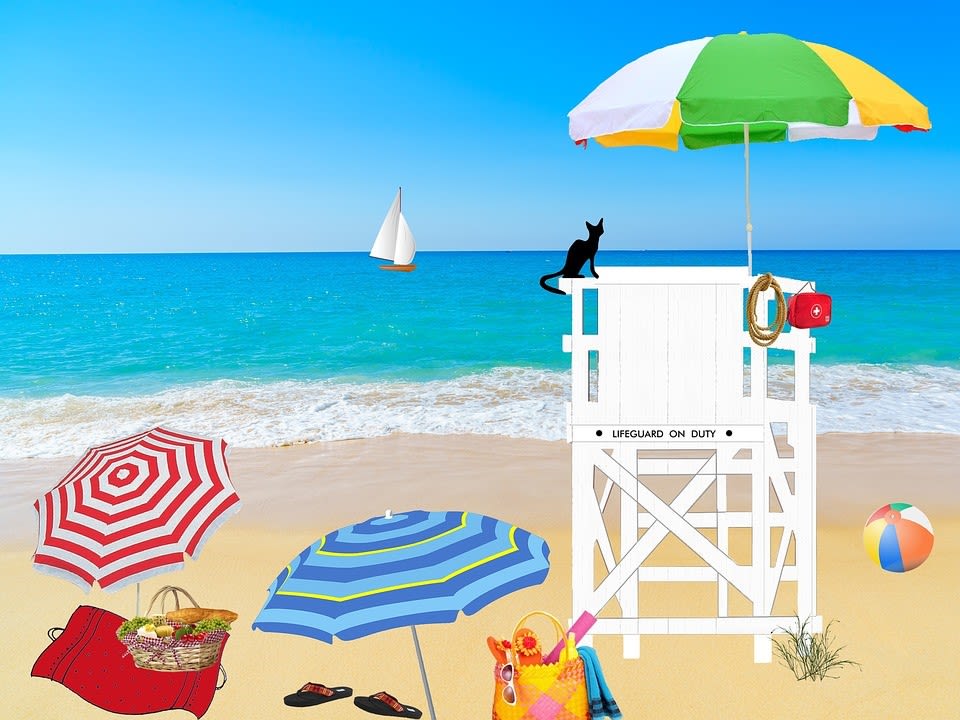Summer Beach Create a Scene, Speech/Language/Reinforcer Activities

Description
19 pages of summer beach scenes, summer/beach items, different sizes and colors of items, sea life, people, question cards, following directions cards, and more. Can be used as a reinforcer for correct productions/responses.
Strategies and techniques
Ways to Use:
Cut out items. Practice labeling or identifying items/vocabulary.
Find items that start or end with a target sound.
Use sample questions/language cards to target Wh- questions and language goals.
Sort/categorize items.
Give items to the boy/girl to target pronouns (his/her, he/she, him/her).
Use pictures as visuals for memory recall tasks (name 3 items, see if they can recall those items).
Create your own questions and commands related to the scenes.
Have the child give you commands to follow using pictured items and scenes.
Have each child create a scene using photos and describe it.
For groups, have children compare/contrast the scenes they created.
Use pictured items as reinforcers for correct articulation productions/answers to language activities.
Use as visuals to create a story/narrative.
Describe items. See if they can guess what you are describing or have them describe items to you.
Cut out items. Practice labeling or identifying items/vocabulary.
Find items that start or end with a target sound.
Use sample questions/language cards to target Wh- questions and language goals.
Sort/categorize items.
Give items to the boy/girl to target pronouns (his/her, he/she, him/her).
Use pictures as visuals for memory recall tasks (name 3 items, see if they can recall those items).
Create your own questions and commands related to the scenes.
Have the child give you commands to follow using pictured items and scenes.
Have each child create a scene using photos and describe it.
For groups, have children compare/contrast the scenes they created.
Use pictured items as reinforcers for correct articulation productions/answers to language activities.
Use as visuals to create a story/narrative.
Describe items. See if they can guess what you are describing or have them describe items to you.
License
Additional information
Resource details

Description
19 pages of summer beach scenes, summer/beach items, different sizes and colors of items, sea life, people, question cards, following directions cards, and more. Can be used as a reinforcer for correct productions/responses.
Strategies and techniques
Ways to Use:
Cut out items. Practice labeling or identifying items/vocabulary.
Find items that start or end with a target sound.
Use sample questions/language cards to target Wh- questions and language goals.
Sort/categorize items.
Give items to the boy/girl to target pronouns (his/her, he/she, him/her).
Use pictures as visuals for memory recall tasks (name 3 items, see if they can recall those items).
Create your own questions and commands related to the scenes.
Have the child give you commands to follow using pictured items and scenes.
Have each child create a scene using photos and describe it.
For groups, have children compare/contrast the scenes they created.
Use pictured items as reinforcers for correct articulation productions/answers to language activities.
Use as visuals to create a story/narrative.
Describe items. See if they can guess what you are describing or have them describe items to you.
Cut out items. Practice labeling or identifying items/vocabulary.
Find items that start or end with a target sound.
Use sample questions/language cards to target Wh- questions and language goals.
Sort/categorize items.
Give items to the boy/girl to target pronouns (his/her, he/she, him/her).
Use pictures as visuals for memory recall tasks (name 3 items, see if they can recall those items).
Create your own questions and commands related to the scenes.
Have the child give you commands to follow using pictured items and scenes.
Have each child create a scene using photos and describe it.
For groups, have children compare/contrast the scenes they created.
Use pictured items as reinforcers for correct articulation productions/answers to language activities.
Use as visuals to create a story/narrative.
Describe items. See if they can guess what you are describing or have them describe items to you.
License
Focus areas
- ST -> Expressive Language -> Answering Questions
- ST -> Expressive Language -> Asking Questions
- ST -> Expressive Language -> Attributes
- ST -> Expressive Language -> Basic Concepts
- ST -> Expressive Language -> Categories
- ST -> Expressive Language -> Commenting
- ST -> Expressive Language -> Comparisons
- ST -> Expressive Language -> Describing
- ST -> Expressive Language -> Differences
- ST -> Expressive Language -> Labeling
- ST -> Expressive Language -> Narrative Development
- ST -> Expressive Language -> Prepositions
- ST -> Expressive Language -> Pronouns
- ST -> Expressive Language -> Syntax
- ST -> Expressive Language -> Utterance Expansion
- ST -> Expressive Language -> Vocabulary
- ST -> Expressive Language -> Verbs
- ST -> Receptive Language -> Adjectives
- ST -> Receptive Language -> Answering Questions
- ST -> Receptive Language -> Basic Concepts
- ST -> Receptive Language -> Categories
- ST -> Receptive Language -> Following Directions
- ST -> Receptive Language -> Nouns
- ST -> Receptive Language -> Prepositions
- ST -> Receptive Language -> Pronouns
- ST -> Receptive Language -> Verbs
- ST -> Receptive Language -> Vocabulary
- ST -> Receptive Language -> Sequencing
23 more focus areas. Click arrow to view all.
Evidence based practice citations
-
What Are Basic Concepts?
Author(s): Super Duper -
How and Why to Teach Categories in Speech Therapy
Author(s): @allison_fors
Grade levels
None
Weekly Themes
Daily Themes
None
Blends
None
Phonemes
None
Activity List
Resource slides
Create a free Ambiki account to preview the slides of this PDF resource.
